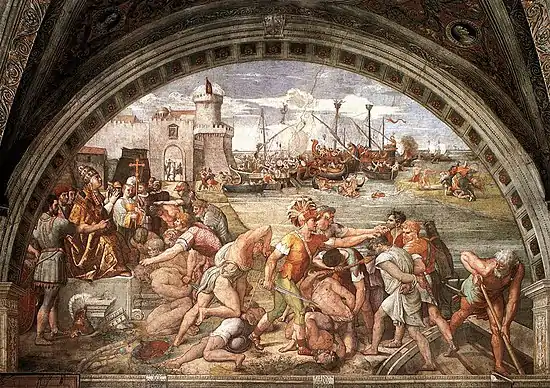| Battle of Ostia | |||||||
|---|---|---|---|---|---|---|---|
 Raphael's fresco The Battle of Ostia, an indication of the battle's legendary fame | |||||||
| |||||||
| Belligerents | |||||||
|
Christian League: | Muslim fleet[lower-alpha 1] | ||||||
| Commanders and leaders | |||||||
| Pope Leo IV | Unknown | ||||||
| Strength | |||||||
| Unknown | Unknown | ||||||
| Casualties and losses | |||||||
| Minimal | Heavy | ||||||
The naval Battle of Ostia took place in 849 in the Tyrrhenian Sea between a Muslim fleet and an Italian league of Papal, Neapolitan, Amalfitan, and Gaetan ships. The battle ended in favor of the Italian league, as they defeated the Muslims. It is one of the few events to occur in southern Italy during the ninth century that is still commemorated today, largely through the walls named after Leo and for the Renaissance painting Battaglia di Ostia by Raphael.
Background
Starting in 827, Muslim forces began the conquest of Sicily and from 835, the Aghlabids began campaigning on the Italian mainland. Their invasions of Calabria and Apulia, as well as their attacks on other central Mediterranean islands, were probably undertaken as an extension of their conquest of Sicily, aiming to aid the conquest by attacking Byzantine positions in the region.[1]: 476 [2]: 208 Rome was raided by a Muslim force in 846, although it is not certain that the raiders came from Aghlabid territory.[3]: 26 [4]: 122 Another attack towards Rome took place in 849, leading to the Battle of Ostia.[3]: 35 [5]
Battle
News of a massing of Muslim ships off Sardinia reached Rome early in 849. A Christian armada, commanded by Caesar, son of Sergius I of Naples, was assembled off recently refortified Ostia, and Pope Leo IV came out to bless it and offer a mass to the troops. After the Muslim ships appeared, battle was joined with the Neapolitan galleys in the lead. Midway through the engagement, a storm divided the Muslims and the Christian ships managed to return to port. The Muslims, however, were scattered far and wide, with many ships lost and others sent ashore. When the storm died down, the remnants of the Muslim fleet were easily picked off, with many prisoners taken.[6]
Aftermath
In the aftermath of the battle, much flotsam and jetsam washed ashore and was pillaged by the locals, per jus naufragii. The prisoners taken in battle were forced to work in chain gangs building the Leonine Wall which was to encompass the Vatican Hill. Rome would never again be approached by a Muslim army.[3]
See also
Notes
References
- ↑ Bondioli, Lorenzo M. (2018). "Islamic Bari between the Aghlabids and the Two Empires". In Anderson, Glaire D.; Fenwick, Corisande; Rosser-Owen, Mariam (eds.). The Aghlabids and Their Neighbors: Art and Material Culture in Ninth-Century North Africa. Brill. pp. 470–490. ISBN 978-90-04-35566-8.
- ↑ Nef, Annliese (2021). "Byzantium and Islam in Southern Italy (7th–11th Century)". A Companion to Byzantine Italy. Brill. pp. 200–225. ISBN 978-90-04-30770-4.
- 1 2 3 Kreutz, Barbara M. (1991). Before the Normans: Southern Italy in the Ninth and Tenth Centuries. University of Pennsylvania Press. ISBN 978-0-8122-0543-5.
- ↑ Davis-Secord, Sarah (2017). Where Three Worlds Met: Sicily in the Early Medieval Mediterranean. Cornell University Press. ISBN 978-1-5017-1258-6.
- ↑ Mazot, Sibylle (2011). "The History of the Aghlabids". In Hattstein, Markus; Delius, Peter (eds.). Islam: Art and Architecture. h.f.ullmann. p. 131. ISBN 978-3848003808.
- ↑ "CAMPANA, LEGA in "Enciclopedia Italiana"". www.treccani.it (in Italian). Retrieved 2022-06-08.
Sources
- Llewellyn, Peter. Rome in the Dark Ages. London: Faber and Faber, 1970.